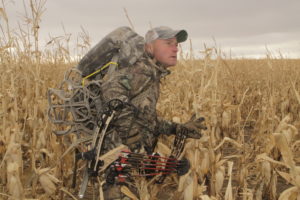What do deer eat? Answer this question and you’ll be one step closer to hunting success. Unfortunately, whitetails eat from a large menu that may include 400 or more different species of vegetation. Research from the University of Missouri Extension has identified more than 600 plant species whitetail dine on in Missouri alone. They require as many as 20 different plant varieties a day just to keep their digestive system working properly. Want to zero in on their favorites? A local biologist or a wildlife land management specialist can help you narrow down the deer diet options in your zip code.
What’s on the menu?
A major supplier of nutrition is browse. Supple leaves and branch tips supply much of a whitetail’s dietary needs. Overall, taste seems to be the major attractant to browse, and favorites depend on the season and region. Whitetails may favor species such as ash, hemlock, maple, aspen, sumac, and even ground-bearing fruit like raspberry or strawberry plants.
During the spring resurgence and on freshly cut hayfields you’ll often see deer grazing on grass varieties. They prefer the soft stems then as opposed to later in summer and fall when grasses dry out and are coarse.

Don’t overlook tractor-produced crops. Depending on the season and harvest schedule, deer flock to soybeans, corn, oats, wheat, alfalfa and a variety of crops for snack-time satisfaction. Mark Kayser surveys a cornfield for an ambush location. Photo: Mark Kayser
Lichens and forbs abound throughout whitetail country, and although they are not as easy to spot as a standing cornfield, deer seek them out during certain times of the year. Both become difficult to use as an ambush location due to their scattered nature, but be aware that deer add them to their munching routine. Mushrooms also fall into this snacking category. When there is a wet period in a mushroom-rich environment you can expect deer to gobble up tasty species as fast as they, well, mushroom.
A final nature’s-way pit stop is mast. Mast includes acorns and chestnuts, which fall into the hard mast category. Fruit trees, like apples, crabapples, pears and plum bushes, fall into the soft mast category. The drier the climate the less likely you’ll have many mast options around. Nevertheless, in the heart of deer country from the Midwest through the eastern United States, mast lures in deer with gusto, particularly in the fall. Deer love mast for its taste, and, with its carbohydrate makeup, it is a good source of energy. In the fall it helps deer gain weight before winter and the upcoming rut. A mature whitetail buck may lose 20 percent or more of its body weight during breeding season, so it needs to go into fall fat and sassy.
Although fruit trees may produce annually, red and white oaks oftentimes produce acorns randomly. One year a tree may have poor production, and the next it may be good. You’ll need to scout to see if the oak in your location is producing any given year.
Whitetails evolved in a tractor-less world, so much of their diet comes straight from untilled fields. That said, don’t overlook tractor-produced crops. Depending on the season and harvest schedule, deer flock to soybeans, corn, oats, wheat, alfalfa and a variety of crops for snack-time satisfaction. These and other regional agricultural crops require constant surveillance, especially around harvest. Deer quickly move from field to field as harvest ensues. It takes away cover, but oftentimes leaves great leftovers.
The power of protein
One important aspect of all food sources is its protein level. Protein is important in overall diet, but it is the main ingredient to a healthy herd. Springtime females require ample amounts of protein in the last weeks before giving birth and that continues as they lactate. Bucks require protein, especially in the spring and summer as they regrow antlers. Antler bone is composed of nearly 50 percent protein.
The University of Missouri Extension research details that whitetails, depending on age, require food with a protein value of six to more than 20 percent. Adequate protein levels can be found in plant species such as alfalfa, clover, brassica, rye, soybeans and winter wheat, plus most of the naturally occurring browse species.
Featured Photo: Mark Kayser






